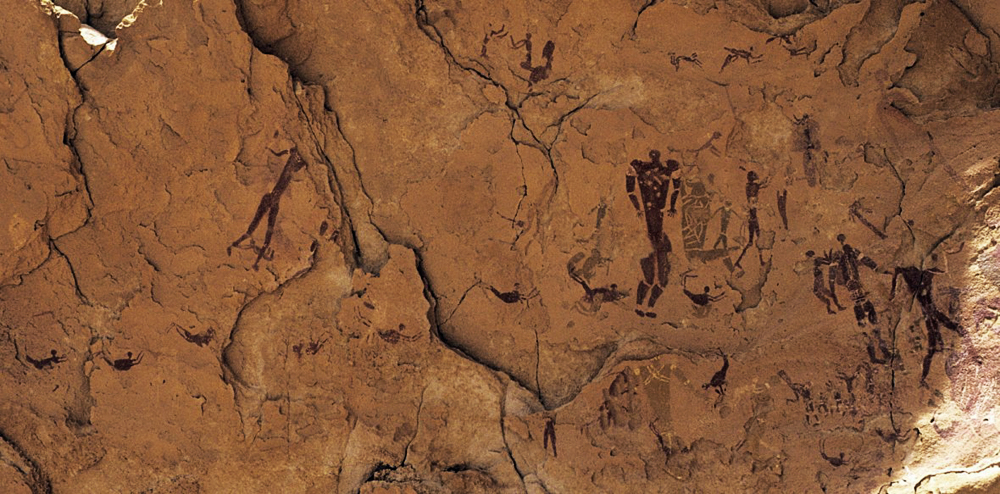


A recent article by Martha Henriques on ibtimes.co.uk - Mysterious 5,000-year history of ancient Libyan rock art revealed - reports on the research of rock art and pottery reflecting the rise and fall of cattle grazing in the Gilf Kebir region.

Rock art in the Cave of Swimmers, showing art in the Wadi Sura style from between about 6100-4800 BCE. Image: Stefan Kröpelin
Archaeologists have established an absolute chronology of prehistoric rock art in the Gilf Kebir region, which stretches across parts of Libya, Sudan and Egypt, for the first time, based on rock art, carbon dating, stratigraphy and other archaeological methods.
Archaeologists have published a new timeline for the art according to three distinct phases in a paper published in the journal Antiquity.
According to study author Stefan Kröpelin of the University of Cologne, the research uses three independent datasets: climate data recorded in the rocks, archaeological data from inside and around the caves analysed by carbon-dating, and analysis of the styles of rock art and their superimposition. All three confirm the same chronology completely independently. (Dates are approximate).
8500 BCE: Epoch Gilf A - groups of hunter-gatherers occupied the area. Summer monsoons influenced the climate of the region leading to heavy rainfall in Gilf Kebir. Only a few examples of rock paintings. Occupation of the area lasted for about 2,000 years.
6500 BCE: Epoch Gilf B - a new phase of human life, with an explosion of art, including ceramics, engravings and a range of painting techniques. The Wadi Sura style became popular in this phase, demonstrated at sites such as the Cave of Swimmers and the Cave of Beasts in western Gilf Kebir.
Gilf Kebir rock art chronology establishedhttps://t.co/pKf2mshqDD #Libya #RockArt #Sahara #Egypt pic.twitter.com/b8K2WLicsm
— Bradshaw Foundation (@BradshawFND) March 21, 2017
Rock art from the Gilf Kebir region in the present-day Sahara desert showing that cattle once grazed there when it was lush and green. Image: Heiko Riemer
4400 BCE: Epoch Gilf C - human inhabitants developed the cattle pastoralist style (above). These paintings feature large groups of cattle with different markings, accompanied by human figures. Change in climate in the region, from short summer monsoon seasons to heavier winter rains, ideal for grazing cattle. Referred to as the golden age of rock art in the Gilf Kebir region, lasting until about 3500 BCE, when the area was abandoned due to aridity and desertification.
Exploring the Rock Art of Gilf Kebir:
http://www.bradshawfoundation.com/africa/gilf_kebir_cave_of_swimmers/index.php
by Bradshaw Foundation
Monday 03 February 2025
by Bradshaw Foundation
Friday 09 August 2024
by Bradshaw Foundation
Wednesday 24 July 2024
by Bradshaw Foundation
Thursday 04 July 2024
by Bradshaw Foundation
Monday 01 July 2024
by Bradshaw Foundation
Wednesday 20 March 2024
by Bradshaw Foundation
Tuesday 13 February 2024
by Bradshaw Foundation
Tuesday 13 February 2024
by Bradshaw Foundation
Thursday 01 February 2024
by Bradshaw Foundation
Tuesday 28 November 2023
by Bradshaw Foundation
Thursday 23 November 2023
by Bradshaw Foundation
Monday 20 November 2023
by Bradshaw Foundation
Tuesday 31 October 2023
by Bradshaw Foundation
Thursday 26 October 2023
by Bradshaw Foundation
Wednesday 20 September 2023
by Bradshaw Foundation
Monday 17 July 2023
by Bradshaw Foundation
Monday 03 February 2025
by Bradshaw Foundation
Friday 09 August 2024
by Bradshaw Foundation
Wednesday 24 July 2024
by Bradshaw Foundation
Thursday 04 July 2024
by Bradshaw Foundation
Monday 01 July 2024
by Bradshaw Foundation
Wednesday 20 March 2024
by Bradshaw Foundation
Tuesday 13 February 2024
by Bradshaw Foundation
Tuesday 13 February 2024
by Bradshaw Foundation
Thursday 01 February 2024
by Bradshaw Foundation
Tuesday 28 November 2023
by Bradshaw Foundation
Thursday 23 November 2023
by Bradshaw Foundation
Monday 20 November 2023
by Bradshaw Foundation
Tuesday 31 October 2023
by Bradshaw Foundation
Thursday 26 October 2023
by Bradshaw Foundation
Wednesday 20 September 2023
by Bradshaw Foundation
Monday 17 July 2023
Friend of the Foundation











